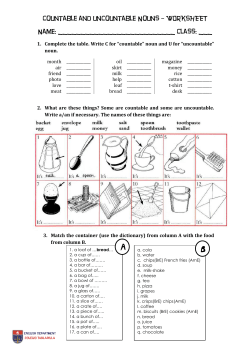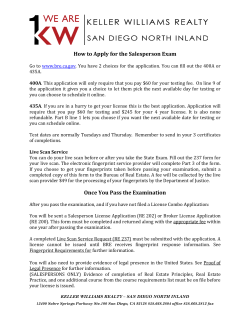
Introduction to English Dialectology Sample questions variety of English?
Answers 1 Introduction to English Dialectology Sample questions BBK Multiple-choice test. Choose the best alternative. 40 pts. 1. What does RP refer to? a. Rhotic Preference b. Received Pronunciation c. Roasted Picts d. Real Pronunciation 2. Which of these areas has the smallest number of native speakers of English? a. England c. South Africa b. North America d. New Zealand 3. Which of these features is NOT characteristic of the linguistic south in England? a. H-Dropping c. unsplit FOOT-STRUT b. BATH-Broadening d. Initial Fricative Voicing 8. Which of the following territories was the last to form its variety of English? a. Newfoundland c. Wales b. Ulster d. Scotland 9. As a result of the Great Vowel Shift, /u:/ as in mouse turned into which present-day RP vowel? a. c. b. d. 10. Which is an incorrect pairing of OE and ME dialects? a. Mercian - East Midland c. Mercian - West Midland b. West Saxon - West Midland d. Northumbrian - Northern 11. Which of these areas does NOT belong to the linguistic north in England? a. the middle north c. the home counties b. the Midlands d. the far north B 2. 4. Which is NOT the name of a language/variety? a. Eire c. Gaelic b. Brogue d. Erse 5. What is the other name of The Scottish Vowel Length Rule? a. Atkin’s Law c. Aitken’s Law b. MOUTH Rule d. NURSE Rule 13. Scouse is spoken in… a. Liverpool b. Newcastle 6. Which is NOT a characteristic of a US English accent? a. Drawl c. Raising b. Hyperrhoticity d. Chain Shift 14. The Southern Drawl characterizes …. a. the South of England c. the South Island of New Zealand b. the South of the US d. South Africa c. TH-fronting in Irish English d. H-dropping in Cockney x x 5. x 6. x 7. x 8. x 9. x 10. x 14. c. London d. Birmingham 15. Which of these is NOT characteristic of Cockney? a. Intrusive-R c. glottal stops b. H-dropping d. rhoticity x 12. 13. 15. D x 3. 4. C x 11. 12. Which does NOT exist? a. Tapping/flapping in Canadian English b. WH-reduction in RP 7. The three main divisions of Australian English are defined a. on the basis of grammatical c. on the basis of lexical differences differences b. in geographical terms d. in social terms A 1. x x x x Answers 2 16. In Australian Rhyming Slang, onkaparinga means 'finger'. This shows that Australian English ... a. has unsplit FOOT/STRUT c. is non-rhotic b. has final -ow reduction d. has unsplit TRAP/BATH 17. If a Cockney says //, s/he means ... a. see c. sigh b. say d. sit 18. Which pronunciation feature is shared by Scots and GA? a. rhoticity c. Aitken's Law b. diphthong shift d. TH-fronting 19. Which statement is NOT true for Canadian English? a. It has surprisingly homogeneous pronunciation b. Northern American English is a common term for US and Canadian Englishes c. Tapping is a distinctive feature of Canadian English by which one can identify that variety d. There are distinctive vocabulary items in Canadian English 20. The difference between creoles and pidgins is that … a. pidgins have no grammar b. pidgins are nobody's mother tongues c. creoles develop into pidgins with time d. creoles are spoken by coloured people 23. Which is not a typical British feature in the pronunciation of Southern Hemisphere English (in general)? a. no contrast between /ə/ c. H-dropping and // in weak syllables b. non-rhoticity d. broad BATH vowel 24. The Cockney pronunciation of New York City does NOT illustrate … a. R-dropping c. Diphthong Shift b. Final ew-reduction d. T-glottalling 25. Which language is NOT Celtic? a. Scottish Gaelic c. Scots b. Welsh d. Irish Gaelic 26. The FOOT/STRUT Split is a characteristic feature of … a. RP only c. GA only b. both RP and GA d. neither RP nor GA 27. Which of the following characterises RP? a. it is a rhotic accent c. it has BATH-broadening b. compensatory lengthening d. it is an unsplit does not take place in it BATH/TRAP accent 21. In Cockney rhyming slang, dog and bone means ... a. log c. phone b. road d. born 28. What is a pidgin? a. a species of bird b. a dialect of Chinese c. a mixed language used as the second language in a multicultural community d. a suprasegmental feature of English 22. In Cockney rhyming slang, have a butcher's means ... a. have a steak c. have a book b. have a baby d. have a look 29. Which of the following accents is traditionally rhotic? a. Eastern US English c. Australian English b. South-west English English d. Geordie A B 16. 17. 18. C x x x 19. x 20. x 21. x 22. 23. 24. x x x 25. 26. x x 27. x 28. 29. D x x Answers 3 30. Which of the following is an American-type accent? a. Scottish English c. Australian English b. Canadian English d. South African English 38. Which is NOT true? a. BrE autumn = AmE fall b. BrE apartment = AmE flat 31. The Severn-Wash line … a. is a major railway route in the US b. is a fundamental accent boundary in England 39. Which word is typically BrE? a. chemist's c. gas 'gasoline' b. store (n) d. sidewalk c. refers to social division in South Africa d. separates rhotic and nonrhotic areas 32. Which of these processes does NOT affect a vowel/vowels? a. diphthong shift c. early yod-dropping b. Canadian Raising d. KIT-split 33. English-based pidgins/creoles are NOT found in … a. the Caribbean c. the Pacific b. West Africa d. China 34. Which of the following words has the same pronunciation in RP and GA? a. lot c. hurry b. dude d. put 35. The name of the letter Z rhymes with … in RP and with … in GA. a. bee; head c. bread; tea b. lead; hid d. key; fed 36. Which is NOT true? a. RP aunt = GA ant b. RP clerk = GA clock c. GA dew = RP do d. GA Korea = RP career 37. Which construction is typically BrE? a. in the hospital c. the River Severn b. on the team d. I don't have time c. BrE football = AmE soccer d. BrE cinema = AmE movies 40. Which word is spelt according to the rules of BrE? a. licence c. splendor b. tire d. traveler A 30. B C x 31. x 32. x 33. x 34. x 35. 36. x x 37. x 38. 39. 40. D x x x
© Copyright 2025





















